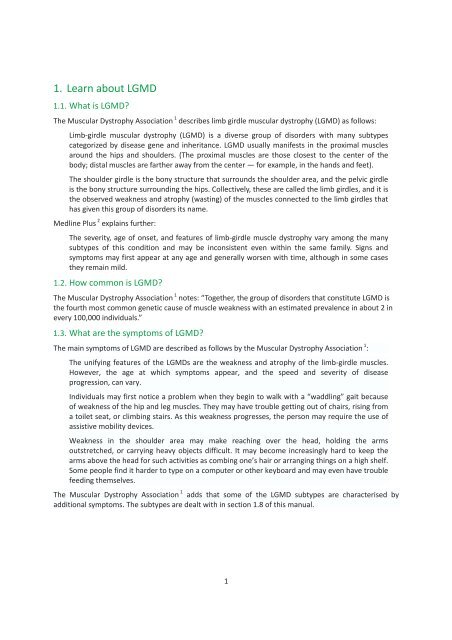You also want an ePaper? Increase the reach of your titles
YUMPU automatically turns print PDFs into web optimized ePapers that Google loves.
1. Learn about <strong>LGMD</strong><br />
1.1. What is <strong>LGMD</strong>?<br />
The Muscular Dystrophy Association 1 describes limb girdle muscular dystrophy (<strong>LGMD</strong>) as follows:<br />
Limb-girdle muscular dystrophy (<strong>LGMD</strong>) is a diverse group of disorders with many subtypes<br />
categorized by disease gene and inheritance. <strong>LGMD</strong> usually manifests in the proximal muscles<br />
around the hips and shoulders. (The proximal muscles are those closest to the center of the<br />
body; distal muscles are farther away from the center — for example, in the hands and feet).<br />
The shoulder girdle is the bony structure that surrounds the shoulder area, and the pelvic girdle<br />
is the bony structure surrounding the hips. Collectively, these are called the limb girdles, and it is<br />
the observed weakness and atrophy (wasting) of the muscles connected to the limb girdles that<br />
has given this group of disorders its name.<br />
Medline Plus 2 explains further:<br />
The severity, age of onset, and features of limb-girdle muscle dystrophy vary among the many<br />
subtypes of this condition and may be inconsistent even within the same family. Signs and<br />
symptoms may first appear at any age and generally worsen with time, although in some cases<br />
they remain mild.<br />
1.2. How common is <strong>LGMD</strong>?<br />
The Muscular Dystrophy Association 1 notes: “Together, the group of disorders that constitute <strong>LGMD</strong> is<br />
the fourth most common genetic cause of muscle weakness with an estimated prevalence in about 2 in<br />
every 100,000 individuals.”<br />
1.3. What are the symptoms of <strong>LGMD</strong>?<br />
The main symptoms of <strong>LGMD</strong> are described as follows by the Muscular Dystrophy Association 1 :<br />
The unifying features of the <strong>LGMD</strong>s are the weakness and atrophy of the limb-girdle muscles.<br />
However, the age at which symptoms appear, and the speed and severity of disease<br />
progression, can vary.<br />
Individuals may first notice a problem when they begin to walk with a “waddling” gait because<br />
of weakness of the hip and leg muscles. They may have trouble getting out of chairs, rising from<br />
a toilet seat, or climbing stairs. As this weakness progresses, the person may require the use of<br />
assistive mobility devices.<br />
Weakness in the shoulder area may make reaching over the head, holding the arms<br />
outstretched, or carrying heavy objects difficult. It may become increasingly hard to keep the<br />
arms above the head for such activities as combing one’s hair or arranging things on a high shelf.<br />
Some people find it harder to type on a computer or other keyboard and may even have trouble<br />
feeding themselves.<br />
The Muscular Dystrophy Association 1 adds that some of the <strong>LGMD</strong> subtypes are characterised by<br />
additional symptoms. The subtypes are dealt with in section 1.8 of this <strong>manual</strong>.<br />
1

















